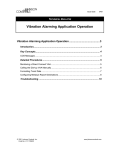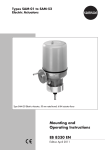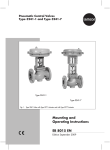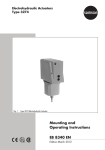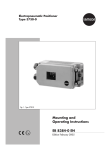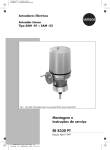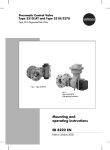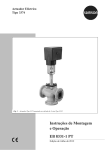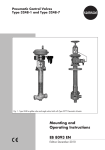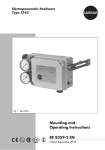Download Mounting and Operating Instructions EB 8072 EN
Transcript
Series 290 Type 3291-1 and Type 3291-7 Pneumatic Control Valves Fig. 1 · Type 3291-1 Control Valve Mounting and Operating Instructions EB 8072 EN Edition November 2011 Contents Contents 1 General safety instructions . . . . . . . . . . . . . . . . . . . . . . . 4 2 2.1 Design and principle of operation. . . . . . . . . . . . . . . . . . . . 5 Transportation and storage . . . . . . . . . . . . . . . . . . . . . . . 5 3 3.1 Assembling valve and actuator. . . . . . . . . . . . . . . . . . . . . . 7 Assembly and adjustment . . . . . . . . . . . . . . . . . . . . . . . . 7 3.2 Pretensioning springs in actuator version "Actuator stem extends". . . . . 8 3.3 3.3.1 3.3.2 Valve and actuator with different rated travels . . . . . . . . . . . . . . 8 Actuator version "Actuator stem extends" . . . . . . . . . . . . . . . . 8 Actuator version "Actuator stem retracts" . . . . . . . . . . . . . . . . 10 4 4.1 Installation . . . . . . . . . . . . . . . . . . . . . . . . . . . . . . 11 Mounting position . . . . . . . . . . . . . . . . . . . . . . . . . . . 11 4.2 Piping design . . . . . . . . . . . . . . . . . . . . . . . . . . . . . 11 4.3 Valve insulation . . . . . . . . . . . . . . . . . . . . . . . . . . . . 11 4.4 Signal pressure line . . . . . . . . . . . . . . . . . . . . . . . . . . 11 4.5 Strainer and bypass . . . . . . . . . . . . . . . . . . . . . . . . . . 12 4.6 Test connection . . . . . . . . . . . . . . . . . . . . . . . . . . . . 12 5 Operation. . . . . . . . . . . . . . . . . . . . . . . . . . . . . . . 13 6 6.1 6.1.1 6.1.2 6.1.3 6.2 6.2.1 6.2.2 6.2.2.1 6.2.2.2 6.2.3 6.2.4 6.2.5 6.2.5.1 6.2.5.2 6.2.5.3 Maintenance – Replacing parts . . . . . . . . . . . . . . . . . . General . . . . . . . . . . . . . . . . . . . . . . . . . . . . . Sealing surfaces . . . . . . . . . . . . . . . . . . . . . . . . . Measuring equipment . . . . . . . . . . . . . . . . . . . . . . Lubricant . . . . . . . . . . . . . . . . . . . . . . . . . . . . Replacing parts of standard version/version with extension bonnet Removing the actuator . . . . . . . . . . . . . . . . . . . . . . Packing and plug . . . . . . . . . . . . . . . . . . . . . . . . Disassembly . . . . . . . . . . . . . . . . . . . . . . . . . . . Assembly . . . . . . . . . . . . . . . . . . . . . . . . . . . . Seat and/or seat retainer/flow divider St I . . . . . . . . . . . . Disassembly . . . . . . . . . . . . . . . . . . . . . . . . . . . Assembly . . . . . . . . . . . . . . . . . . . . . . . . . . . . Height H1 . . . . . . . . . . . . . . . . . . . . . . . . . . . . Gasket height H2 . . . . . . . . . . . . . . . . . . . . . . . . Spacer ring . . . . . . . . . . . . . . . . . . . . . . . . . . . 2 EB 8072 EN . . . . . . . . . . . . . . . . . . . . . . . . . . . . . . . . . . . . . . . . . . . . . . . . 13 13 14 15 15 15 15 16 16 16 16 16 17 18 19 20 Contents 6.2.5.4 6.2.5.5 6.2.5.6 6.2.5.7 6.2.5.8 6.3 6.3.1 6.3.2 6.3.2.1 6.3.2.2 6.3.2.3 6.3.2.4 6.3.3 6.3.3.1 6.3.3.2 6.3.3.3 6.3.3.4 6.3.3.5 6.4 Bonnet gasket . . . . . . . . . . Plug. . . . . . . . . . . . . . . Bonnet . . . . . . . . . . . . . Packing . . . . . . . . . . . . . Threaded bushing . . . . . . . . Valves with bellows section. . . . Removing the actuator . . . . . . Disassembly . . . . . . . . . . . Bellows seal . . . . . . . . . . . Plug. . . . . . . . . . . . . . . Bellows bonnet . . . . . . . . . Plug stem with bellows . . . . . . Assembly . . . . . . . . . . . . Bellows section . . . . . . . . . Bellows bonnet . . . . . . . . . Plug for version with bellows seal. Bellows section with plug. . . . . Additional assembly instructions . Balanced valves . . . . . . . . . . . . . . . . . . . . . . . . . . . . . . . . . . . . . . . . . . . . . . . . . . . . . . . . . . . . . . . . . . . . . . . . . . . . . . . . . . . . . . . . . . . . . . . . . . . . . . . . . . . . . . . . . . . . . . . . . . . . . . . . . . . . . . . . . . . . . . . . . . . . . . . . . . . . . . . . . . . . . . . . . . . . . . . . . . . . . . . . . . . . . . . . . . . . . . . . . . . . . . . . . . . . . . . . . . . . . . . . . . . . . . . . . . . . . . . . . . . . . . . . . . . . . . . . . . . . . . . . . . . . . . . . . . . . . . . . . . . . . . . . . . . . . . . . . . . . . . . . . . . . . . . . . . . . . . . . . . . . . . . . . . . . . . . . . . . . . . . . . . . . . . . . . . . . . . . . . . . . . . . . . . 21 21 22 23 23 24 24 24 24 24 25 25 26 26 26 27 28 28 29 7 7.1 Appendix . . . . . . . . . . . . . . . . . . . . . . . . . . . . . . . 29 Tools . . . . . . . . . . . . . . . . . . . . . . . . . . . . . . . . . 29 7.2 Tightening torques (1120-1400) . . . . . . . . . . . . . . . . . . . . 29 7.3 Spacer rings (1120-3074) . . . . . . . . . . . . . . . . . . . . . . . 30 8 8.1 Description of nameplates . . . . . . . . . . . . . . . . . . . . . . . 30 Type 3291 Valve . . . . . . . . . . . . . . . . . . . . . . . . . . . 30 8.2 Type 3277 Actuator . . . . . . . . . . . . . . . . . . . . . . . . . . 31 8.3 Type 3271 Actuator . . . . . . . . . . . . . . . . . . . . . . . . . . 31 9 Customer inquiries . . . . . . . . . . . . . . . . . . . . . . . . . . 32 10 Dimensions and weights. . . . . . . . . . . . . . . . . . . . . . . . 32 Note: Non-electrical actuators and valves do not have their own potential ignition source according to the risk assessment in the rare incident of an operating fault, corresponding to EN 13463-1: 2001 paragraph 5.2, and therefore do not fall within the scope of the European Directive 94/9/EC. EB 8072 EN 3 General safety instructions 1 General safety instructions 4 The control valve must only be mounted, started up or serviced by fully 4 4 4 4 trained and qualified personnel, observing the accepted industry codes and practices. Make sure employees or third persons are not exposed to any danger. All safety instructions and warnings in these mounting and operating instructions, particularly those concerning assembly, start-up and maintenance, must be observed. The control valves fulfill the requirements of the European Pressure Equipment Directive 97/23/EC. Valves with a CE marking have a declaration of conformity that includes information about the applied conformity assessment procedure. For appropriate operation, make sure that the control valve is only used in areas where the operating pressure and temperatures do not exceed the operating values which are based on the valve sizing data submitted in the order. The valve must be given adequate time to warm up or cool down according to the prevailing ambient and operating conditions. The manufacturer does not assume any responsibility for damage caused by external forces or any other external influence! Any hazards which could be caused in the control valve by the process medium, operating pressure, signal pressure or by moving parts are to be prevented by means of the appropriate measures. Proper shipping and appropriate storage of the control valve are assumed. CAUTION! 4 For installation and maintenance work on the valve, make sure the relevant 4 4 4 EB 8072 EN section of the pipeline is depressurized and, depending on the process medium, drained as well. If necessary, allow the control valve to cool down or warm up to reach ambient temperature prior to starting any work on the valve. Prior to performing any work on the valve, make sure the supply air and control signal are disconnected or blocked to prevent any hazards that could be caused by moving parts. Special care is needed for pneumatic control valves when the actuator springs are pretensioned. These actuators are labeled correspondingly and can also be identified by three long bolts protruding from the bottom of the actuator. Prior to starting any work on the control valve, relieve the compression from the pretensioned springs. Design and principle of operation 2 Design and operation principle of The Type 3291-1 and Type 3291-7 Pneumatic Control Valves consist of the Type 3291 Globe Valve with clamped-in seat combined with either a Type 3271 or a Type 3277 Pneumatic Actuator with integral positioner and/or limit switch attachment. The process medium flows through the valve in the direction indicated by the arrow. The position of the plug determines the flow rate across the seat. Its position is determined by changes in the signal pressure acting on the actuator diaphragm. The plug stem is connected to the diaphragm stem by the stem connector. The stems are sealed by a spring-loaded PTFE V-ring packing or an adjustable high-temperature (HT) packing. Fail-safe position Depending on how the springs are arranged in the actuator, the control valve assumes one of two different fail-safe positions: Actuator stem extends: When the pressure is reduced or the supply air fails, the actuator springs move the actuator stem downwards and close the valve. The valve opens when the signal pressure rises opposing the force of the springs. Actuator stem retracts: When the pressure is reduced or the supply air fails, the actuator springs move the actuator stem upwards and open the valve. The valve closes when the signal pressure rises opposing the force of the springs. 2.1 Transportation and storage These instructions provide information on the correct handling of valves during transportation, storage and hoisting. NOTICE Do not lift the control valve assembly using the actuator's lifting ring. This lifting ring is only intended for lifting the actuator without the valve. Attach the lifting support to the valve body. 4 Leave control valves in their transport container or on the pallet as long as possible. 4 Store valves in a dry place until installation. 4 The transport and storage temperature for valves must be kept between –20 and 65 °C. 4 Protect the valves (especially the dia- phragm stem) against knocks and vibrations etc. 4 Any damage to corrosion protection (paintwork, oiled surfaces etc.) must be remedied immediately 4 Always wear protective gloves, clothing and eyewear when performing any work on the valve. 4 Never leave the load suspended in mid-air. 4 Prior to lifting any valve, always check the weight of the load in SAMSON's technical documentation. 4 Always use lifting equipment according to the actual load of the lifting goods. EB 8072 EN 5 Design and principle of operation 4 Carefully lift the load off the ground and 4 Remove the protective caps from the check that all lifting supports are securely attached and that the control valve is well balanced. 4 Lift the control valve in the position in which it will be installed. valve inlet and outlet shortly before installing the valve in the pipeline. 4 Make sure that the control valve is properly installed before removing the lifting supports. 4 Lift the control valve at its center to pre- 4 Refer to the diagram showing how a 4 For valves weighing over 25 kg, make 4 Attach the slings around the valve body. vent it from tipping to one side. sure that mounting rings for chain hoists are fitted at an adequate height above the installation site. Often, it is recommendable to use sliding rails or swivel arms with a hoist. Fig. 2 · Safe lifting of the valve 6 EB 8072 EN valve can be lifted at the installation site. To keep the valve in the upright position and to prevent it from tipping, attach a sling to the lifting ring of the actuator. Assembling valve and actuator 3 Assembling valve and actuator Instead of a simple pneumatic actuator, the valve can be operated by a pneumatic actuator with additional handwheel or by an electric actuator. The standard pneumatic actuator can be replaced with a larger or smaller actuator for all valve sizes. If the travel range of the actuator is larger than that of the valve, the actuator springs are preloaded by the manufacturer so that the travels match. Each valve is supplied with parts required for a standard valve. If another actuator is to be mounted on the valve, the mounting parts must be ordered together with the actuator. Refer to the documents 1600-0501 to 1600-0550 to find out which parts are required. The originally used parts must then be replaced by the additionally ordered parts. 3.1 Assembly and adjustment If the valve and actuator have not been pre-assembled by the manufacturer, or if the actuator of a valve is to be replaced by an actuator of another type or another size, proceed as described below: 1. Undo the lock nut (10) and stem connector nut (9). Firmly press the plug (5) together with the plug stem into the seat (4). Thread the stem connector nut (9) and lock nut (10) downwards. 2. Remove stem connector clamps (A27) and unscrew nut (A8) from the actuator. Slide the nut over the plug stem (mount dust sleeve, if necessary). 3. Place actuator onto the yoke (3) and secure with the nut (A8). 4. Read bench range (or bench range with preloaded springs) and fail-safe action from the actuator's nameplate (e.g. 0.2 to 1 bar and "Actuator stem extends"). The lower value of the bench range (0.2 bar) corresponds to the lower bench range value to be adjusted, while the upper bench range value (1 bar) corresponds to the upper bench range value. The fail-safe action "Actuator stem extends" (FA) or "Actuator stem retracts" (FE) is indicated on the Type 3271 and Type 3277 Actuator by the corresponding symbol. 5. For actuators with "Actuator stem extends", apply a signal pressure to the bottom diaphragm chamber which corresponds to the lower bench range value (e.g. 0.2 bar). For actuators with "Actuator stem retracts", apply a signal pressure to the top diaphragm chamber which corresponds to the upper bench range value (e.g. 1 bar). 6. Thread the stem connector nut (9) by hand until it touches the actuator stem (A7). Then, turn it another ¼ turn and secure this position with the lock nut (10). 7. Position the stem connector clamps (A27) and fasten. Align the travel indicator scale (83) with the tip of the stem connector. EB 8072 EN 7 Assembling valve and actuator Note on disassembling the actuator Before disassembling an actuator with fail-safe action "Actuator stem extends" and particularly an actuator with preloaded springs, apply a pressure to the signal pressure connection (S) that slightly exceeds the lower bench range value (see nameplate of the actuator) to allow the nut (A8) to be undone. 3.2 Pretensioning springs in actuator version "Actuator stem extends" To achieve a greater positioning force, the springs in actuators with "Actuator stem extends" can be preloaded with up to 25 % of their travel or bench range. If the springs are preloaded with, for example, 0.1 bar for a bench range of 0.2 to 1 bar, the bench range is shifted by 0.1 bar to result in a bench range of 0.3 to 1.1 bar (0.1 bar corresponds to a preload of 12.5 %). When adjusting the valve, the lower bench range is to be set to 0.3 bar. Make sure the new bench range of 0.3 to 1.1 bar is indi- Legend for Fig. 3 1 Valve body 2 Bonnet 3 Yoke 4 Seat 5 Plug 7 Guide bushing 8 Threaded bushing 9 Stem connector nut 10 Lock nut 13 Stud bolt 8 EB 8072 EN 14 15 17 83 92 124 125 126 127 cated on the nameplate as the bench range with preloaded springs! 3.3 Valve and actuator with different rated travels 3.3.1 Actuator version "Actuator stem extends" NOTICE Valves that have a travel smaller than the rated travel of the actuator always need to use preloaded springs. Example: Valve with 30 mm rated travel and 1400 cm² actuator with 60 mm rated travel, 0.4 to 2 bar bench range. 1. Set the signal pressure to 1.6 bar. This pressure is slightly higher than the signal pressure of 1.2 bar required for tensioning the springs (1.2 to 2 bar range) which corresponds to half the actuator travel (30 mm). 2. Thread stem connector nut (9) until it touches the actuator stem (A7). Nut Packing Gasket Travel indicator scale Nut Seat retainer Spacer ring Gasket Gasket Actuator A1 Top diaphragm case A2 Bottom diaphragm case A4 Diaphragm A7 Diaphragm stem A8 Nut A16 Venting A27 Stem connector clamp S Signal pressure connection Assembling valve and actuator A16 A1 A4 S A8 A2 A7 3 83 A27 9 92 10 17 8 15 125 13 14 126 2 124 7 1 5 4 127 Fig. 3 · Type 3291-1 Control Valve EB 8072 EN 9 Assembling valve and actuator 3. Secure the position with lock nut (10) and attach stem connector as described in section 3.1. 4. Enter the 1.6 to 2.4 bar bench range valid for the mounted valve on the nameplate of the actuator. 3.3.2 Actuator version "Actuator stem retracts" Note: The springs in the actuator version "Actuator stem retracts" cannot be preloaded! If a valve is to be attached to a larger actuator (rated travel of actuator larger than the rated travel of the valve), only the first half of the bench range of the actuator can be used. Example: Valve with 30 mm rated travel and 1400 cm² actuator with 60 mm rated travel, 0.2 to 1 bar bench range: A useable bench range of 0.2 to 0.6 bar is available for the half valve range. 10 EB 8072 EN CAUTION! Actuators which have been preloaded by the manufacturer without an attached valve are marked by a label. In addition, you will notice three extended bolts on the bottom diaphragm case. They enable you to evenly relieve the compressed springs when disassembling the actuator. Installation 4 Installation 4.3 Valve insulation NOTICE The valve must be installed with the least amount of vibrations possible and without any stress. Control valves with bellows seal or extension bonnet can only be insulated up to the bonnet flange of the valve body when the medium temperature is below 0 °C or above 220 °C. 4.1 Valves used in applications according to NACE MR 0175, NACE MR 0103 or ISO 15156 must not be insulated. Mounting position The valve can be mounted in any desired position. However, vertical installation with the actuator pointing upwards is preferable for valves in NPS 4 and larger to facilitate maintenance. For valves with extension bonnet or bellows seal, or for actuators weighing more than 50 kg, mount a suitable support or suspension for the actuator. 4.2 Piping design 4.4 Signal pressure line Connect the signal pressure line to the bottom diaphragm case for valves with actuator version "Actuator stem extends" and to the top diaphragm case for valves with actuator version "Actuator stem retracts". The bottom signal pressure connection of the Type 3277 Actuator is located at the side of the yoke of the bottom diaphragm case. To allow the control valve to work properly, the pipeline upstream of the valve must be straight and free of obstructions for a length twice to 10 times of the pipe diameter (NPS) and the pipeline downstream of the valve for a length at least 4 to 20 times of the pipe diameter (NPS), depending on the process conditions or for process media containing solids. Contact SAMSON if this length cannot be met during installation. Clean out the pipeline thoroughly prior to installing the valve. Fig. 4 · Type 3277 with signal pressure connection at the side for "Actuator stem extends" EB 8072 EN 11 Installation 4.5 Strainer and bypass We recommend installing a strainer upstream of the valve body. We also recommend installing a shut-off valve both upstream of the strainer and downstream of the valve as well as laying a bypass so that you do not need to shut down the plant for maintenance. 4.6 Test connection A test connection at the top flange of a valve version with bellows seal allows the bellows seal to be monitored for leaks. Particularly for liquids and vapors, we recommend installing a suitable leak indicator at the test connection, such as a contact pressure gauge, an outlet into an open vessel or an inspection window. Fig. 5 · Test connection above the bellows seal 12 EB 8072 EN Operation 5 Operation (e.g. reversing the fail-safe action of the actuator etc.) For details, refer to Mounting and Operating Instructions EB 8310 EN for Type 3271 and EB 8311 EN for Type 3277 6 Maintenance – Replacing parts The control valve is subject to natural wear, especially at the seat, plug and packing. Depending on the application, the valve needs to be checked regularly to prevent against possible failures. 6.1 General If leakage occurs, this could be caused by a damaged packing or a defective bellows seal. If the valve does not seal properly, the tight shut-off may be impeded by dirt or other impurities caught between the seat and plug, or by damaged seating surfaces. Remove the parts, clean them thoroughly and replace them with new ones, if necessary. CAUTION! Before servicing or disassembling the control valve, depressurize the concerned section of the plant and drain it, if necessary, depending on the medium used. Wait until the valve cools down to ambient temperature if the process medium is hot. As valves are not free of cavities, beware that there might still be residual medium in the valve. This applies, in particular, for valve versions with extension bonnet and bellows seal. We recommend removing the valve from the pipeline. EB 8072 EN 13 Maintenance – Replacing parts NOTICE On performing any work on the valve, first shut off the signal pressure, disconnect the signal pressure line and remove the actuator. Note: When mounting the valve bonnet, the large port of the V-port plug and one of the openings of the seat retainer must face the valve outlet. DF 10 6.1.1 Sealing surfaces Make sure all sealing surfaces of the valve (DF 1 to DF 10) are clean. Check that newly inserted gaskets are undamaged, free of burrs from punching and properly seated. DF 8 und 9 DF 5 If new spacer rings are required, they must also be free of burrs and flat. DF 4 Note: Only one spacer ring (125) and one gasket (126) may be used for valves up to NPS 4 for height compensation. Several spacer rings (125) and gaskets (126) can be used for valves in NPS 6 or larger. The rings and gaskets must be installed in alternating sequence. yyy yy yyy DF 3 DF 7 DF 2 NOTICE To prevent damage to the internal parts, sealing surfaces and threads, proceed carefully while assembling or disassembling the valve. During all work performed on the valve, strictly observe the specified tightening torques in Table 5 (according to document 1120-1400). 14 EB 8072 EN DF 1 Fig. 6 · Sealing surfaces DF 1 to DF 10 DF 6 Maintenance – Replacing parts 6.1.2 Measuring equipment To measure the heights, only use measuring equipment that remains aligned at an angle to the dimension to be measured. Appropriate measuring equipment includes, for example, a dial indicator gauge with magnetic base, vernier depth gauge or depth gauge with bridge. To measure the gaskets, a caliper may also be used, provided the wider jaws (and not the blades) are used for measuring. Make absolutely sure that no pressure is exerted on the gasket to prevent the gasket from becoming deformed. 6.1.3 Lubricant Note: Contact your nearest SAMSON subsidiary or the SAMSON After-sales Service department for information on suitable lubricants. Apply a suitable lubricant to the plug stem (5) in area where the PTFE packing is located as well as to the individual parts of the PTFE packing (15). In valves with balanced plugs, additionally apply lubricant to the pressure balancing sleeve and the bearing strip. Note: Do not apply lubricant to the packing parts or plug stem when a graphite packing is used. Similarly, do not apply lubricant to the pressure-balancing sleeve or bearing strip when graphite pressure-balancing parts are used in the valve. For corrosion protection and friction reduction, apply a suitable grease to the following parts: Threads of the bolts (13, 32), threads and bearing face of the nuts (14, 33), thread and sealing surface of the threaded bushing (8), threads of the stem connector nut (9) and lock nut (19), threads and screw head faces of the pressure-balancing assembly. 6.2 Replacing parts of standard version/version with extension bonnet The instructions below describe the procedure for the standard version with bonnet (2). The same procedure applies to the version with extension bonnet (21). 6.2.1 Removing the actuator The actuator and yoke must be removed to perform maintenance or repair on the valve. Pneumatic actuator with fail-safe action "Actuator stem extends" 1. Remove clamp (A27). 2. Apply a pressure to the bottom signal pressure connection that slightly exceeds the lower bench range value (see nameplate). As a result, the actuator stem lifts off the plug stem, making the actuator stem line free of tension. 3. Undo nut (92) and lift the actuator together with yoke off the valve. Pneumatic actuator with fail-safe action "Actuator stem retracts" Proceed in the same manner as described for actuator with fail-safe action "Actuator EB 8072 EN 15 Maintenance – Replacing parts stem extends". However, pressure does not need to be applied to the signal pressure connection. 6.2.2 Packing and plug If the process medium leaks from the threaded bushing (8), this means the packing is leaking. A damaged or blocked PTFE packing must be replaced. If a high-temperature (HT) packing is installed, the threaded bushing (8) can be slightly retightened to stop the packing from leaking. As soon as the valve leaks constantly, check the plug and seat. Clean, machine or replace the plug and seat as required. 6.2.2.1 Disassembly 1. Remove threaded bushing (8) and nuts (14) from the bonnet (2). 2. Carefully lift the bonnet (2) with plug (5) and the plug stem off the body (1). 3. Unscrew stem connector nut (9) and lock nut (10) from the plug stem. 4. Pull the plug together with plug stem from underneath out of the bonnet. Carefully check the sealing surface. Note: The plug must be replaced if any slight damage to the seating surface cannot be removed by machining. 5. Use a packing tool to pull all the packing parts (PTFE V-rings, washers, bushing, 16 EB 8072 EN spring) upwards out of the packing chamber. Carefully clean the packing chamber. 6. Check the parts for damage. Replace any damaged parts. 6.2.2.2 Assembly Note: Prior to mounting the plug, bonnet and packing, renew all gaskets (127, 126, 17) at the seat (4) and seat retainer (124). For this, you need to determine again the required thickness of the spacer ring (up to NPS 4) or spacer rings (NPS 6 or higher). 6.2.3 Seat and/or seat retainer/flow divider St I If parts, such as the seat or seat retainer, have been replaced with new ones due to leakage or wear, we recommend replacing the packing at the same time (see section 6.2.2.1). The flow divider St I is used instead of the seat retainer (124) in versions with flow divider. The procedure to assemble or disassemble the valve is performed in the corresponding manner. 6.2.4 Disassembly 1. Unthread nut (14). 2. Carefully lift the bonnet (2) with plug (5) and the plug stem out of the body (1). 3. Remove all the parts from inside the valve body and place them in order on a flat surface: - Gasket (17) Maintenance – Replacing parts - Spacer ring(s) (125) - Gasket(s) (126) - Seat retainer (124) or flow divider St I - Seat (4) - Gasket (127) 4. Clean spacer ring(s), seat retainer and seat. Check these parts for damage. Machine or replace the seat retainer and seat, if necessary. of the seat bridge. Make absolutely sure that the seating surface and mating surface do not get damaged. The seat has a clear amount of clearance within the seat bridge and is aligned centrally to the valve body's neck. 1 4 Note: First determine the required thickness of the spacer ring(s). Only after this, it is possible to know whether they can be reused. The gaskets must be replaced at any rate. 127 Fig. 8 · Installing the seat (4) 6.2.5 Assembly Note: When assembling internal parts, read the instructions concerning the sealing surface (section 6.1.1) and measuring equipment (section 6.1.2). 1. Insert new gasket (127) of the seat bridge. 2. Carefully place the seat (4) through the valve body's neck onto the gasket (127) 3. Insert the seat retainer (124) into the body as centrally as possible. Otherwise, it may get stuck in the area of the valve body's neck. If it does get stuck, the seat retainer can be aligned centrally using a soft rubber hammer until it is further inserted into the body. Carefully insert the seat retainer into the seat, aligning the seat centrally. To check whether the seat retainer sits correctly on the seating surface, slightly lift and lower the seat retainer. 124 1 1 127 4 127 Fig. 7 · Gasket (127) for seat bridge Fig. 9 · Installing the seat retainer (124) EB 8072 EN 17 Maintenance – Replacing parts 2. Write the values 1 to 3 down in Table 1 in the appropriate columns. Calculate the mean value of H1 from these values and note it in the H1actual column. Align the seat retainer so that one of its openings faces the valve outlet. 6.2.5.1 Height H1 3. Calculate the difference ∆H between the target height H1target and the actual height H1actual and note it in the appropriate column. H1 H1 To determine the height H1 between the inside seating surface (DF 3) of the seat retainer (124) and the outside seating surface (DF 6) of the valve body (1), proceed as follows. 1 127 Fig. 11 · Detailed view of height H1 Fig. 10 · Determining the height H1 1. Measure height H1 at three locations distributed evenly around the circumference of the valve body's neck. Table 1 · Determining the height H1 NPS H1target [mm] ½ to 1 4.8 1½ 5.1 2 5.1 3 5.1 4 5.1 18 6 9.9 8 10.1 EB 8072 EN H1value 1 [mm] H1value 2 [mm] H1value 3 [mm] H1actual [mm] ∆H = H1target – H1actual [mm] Maintenance – Replacing parts 6.2.5.2 Gasket height H2 126 124 1 1. Prior to assembly, measure the height H2actual of the new gasket (126, up to NPS 4) or gaskets (126, NPS 6 or larger) at three locations distributed evenly around the circumference of the valve body's neck. H2 Fig. 13 · Inserting the gasket (126) 126 Note: For valves in NPS 6 or larger, gaskets (126) and spacer rings (125) are inserted into the groove of the seat retainer in alternating sequence. Fig. 12 · Determining height H2 of gasket (126) 126 2. Write down the three values in Table 2 in the appropriate columns. 124 1 3. Calculate the mean value from these values and note it in the H2actual column. 4. Insert gasket (126) into the groove of the seat retainer (124). Fig. 14 · Exact position of the gasket (126) Table 2 · Determining the height H2 Number of gaskets (one gasket up to NPS 4 two gaskets from NPS 6) H2value 1 [mm] H2value 2 H2value 3 H2actual [mm] [mm] [mm] EB 8072 EN 19 Maintenance – Replacing parts 6.2.5.3 Spacer ring 1. Calculate the total height ttotal of the required spacer rings (125) using the previously measured values and write down the result in Table 3 in the appropriate column. 2. Select the spacer rings for the required total height ttotal using the List of Accessories 1120-3074. 125 126 124 1 NOTICE For height compensation, only one spacer ring can be used for valves sizes up to NPS 4. For valves in NPS 6 and larger, several spacer rings can be used as calculated in Table 3 or from the valve parts list. 3. Carefully place the spacer ring (125) onto the gasket (126) between the seat retainer (124) and valve body (1). For valves in NPS 6 and larger, place the gasket (126) and spacer ring (125) in alternating sequence until all the gaskets and spacer rings are installed. Note: The spacer rings must not rest on any part of the seating surface (DF 6) of the valve body. Fig. 15 · Spacer ring (125) on gasket (126) Table 3 · Selecting the spacer ring Height T [mm] Tolerance [mm] 6.1 – ∆ – H2actual – 0.1 1 12.1 – ∆ – H2actual_total –0.1 2 NPS Ideal height ttotal [mm] Number of spacer rings ½ to 1 1½ 2 3 4 6 8 20 EB 8072 EN Maintenance – Replacing parts 6.2.5.4 Bonnet gasket 6.2.5.5 Plug 1. Place gasket (17) into the groove of the seat retainer and the body. The gasket must not jut out over the seating surface (DF 6) of the valve body (1). 17 125 126 1 124 Note: For valves with bellows section, the bellows section (bonnet) and plug are ready-assembled in one unit. Proceed as described in section 6.3. 1. Apply a suitable lubricant to the plug stem (5) around the area where the PTFE packing will be located. 2. Carefully insert the plug into the seat (4) and align it so that the large port faces the valve outlet (port that will be first to release the flow rate when the valve starts to stroke). Fig. 16 · Gasket (17) on spacer ring (125) Note: A slight height difference (S) exists between the bonnet gasket and the sealing surface of the valve body. NOTICE Do not apply any lubricant when a high-temperature (HT) packing is used. 17 125 126 124 1 Fig. 18 · Inserting the plug (5) Fig. 17 · Detailed view of bonnet gasket (27) EB 8072 EN 21 Maintenance – Replacing parts Table 4 · Tightening torques for nuts (14) 6.2.5.6 Bonnet 1. Carefully place bonnet over the plug stem onto the bonnet gasket (17). 2. Apply a suitable lubricant to the threads of the stud bolts (13) and nuts (14) as well as to bearing face of the nuts. NPS Tightening torque [Nm] Class 300 Class 600 60 60 ½ to 1 1½ 68 68 2 112 112 3 118 118 4 100 100 6 296 296 8 On req. 1040 Class 900 On request 2 17 1 6. Repeat this tightening procedure using 100 % of the specified tightening torque. 7. Finally, retighten all the nuts in clockwise order with the full tightening torque one last time. Make sure the nuts are completely tightened and cannot be turned any further. Fig. 19 · Mounting the bonnet (2) 3. Tighten the nuts in a criss-cross pattern applying 50 % of the specified tightening torque. 4 6 1 2 5 7 Note: The gasket (126) under the spacer ring yields, meaning tightening the nuts once is not sufficient. 4. Repeatedly retighten the nuts with 50 % of the specified tightening torque until the nuts cannot be turned any further. 5. Repeat this tightening procedure using 75 % of the specified tightening torque. 22 EB 8072 EN 8 3 Fig. 20 · Tightening the nuts (14) Maintenance – Replacing parts 6.2.5.7 Packing 1. Apply a suitable lubricant to the individual parts of the PTFE packing. 8 2. Carefully slide all the packing parts (15) over the plug stem into the packing chamber in the bonnet. Make absolutely sure that they are inserted in the correct order. Note: The number of spacer bushings to be used depends on the valve size (NPS) which determines the size of the packing chamber. 15 6.2.5.8 Threaded bushing 1. Apply a suitable lubricant to the thread and sealing surface of the threaded bushing (8). 2. Slide threaded bushing over the plug stem and screw it into the bonnet. Note: When a high-temperature (HT) packing is used, only tighten the threaded bushing a little. If the medium leaks out at the threaded bushing, you can retighten the threaded bushing slightly. 3. When a PTFE packing is installed, tighten the threaded bushing. Mount the yoke and actuator as described in section 3.1. Fig. 21 · Packing (15) and threaded bushing (8) EB 8072 EN 23 Maintenance – Replacing parts 6.3 Valves with bellows section For valves with bellows section, the bellows section containing the plug stem and bellows is mounted as one unit. 6.3.1 Removing the actuator Remove the actuator as described in section 6.2.1. 6.3.2 Disassembly 6.3.2.1 Bellows seal 1. Unscrew nut (14) and remove it. 2. Lift complete bellows section assembly out of the body. 9 10 8 3. Clamp the bellows section in a suitable apparatus to perform further work on it. Do not apply a load to the bellows or twist it. 15 101 42 39 (2x) 33 6.3.2.2 Plug 22 Valves up to NPS 1½ 1. Place an open-end wrench on the flattened area of the plug stem to hold it stationary and unscrew nut (6) from plug (29). 37 2. Remove plug from hexagon end of the plug stem. 14 17 6 4 29 Fig. 22 · Type 3291 with bellows section 24 EB 8072 EN Fig. 23 · Plug for valves up to NPS 1½ Maintenance – Replacing parts Valves in NPS 2 and larger 6.3.2.4 Plug stem with bellows 1. Bend back the edges of the lock plate (31) from the heads of the screws (34). 1. Lift off top gasket (39). 2. Remove the screws (34). 3. Unscrew the plug (29) from the plug stem and remove it. 34 2. Lift the plug stem/bellows assembly (37) upwards out of the bellows section (22). The second gasket (39) at the bottom is now accessible. 31 27 28 101 Fig. 24 · Plug for valves in NPS 2 and larger 6.3.2.3 Bellows bonnet 1. Unthread stem connector nut (9) and lock nut (10). Unscrew threaded bushing (8). 2. Remove nuts (33) for bellows bonnet (101). DF 14 DF 13 39 37 DF 12 DF 11 39 22 3. Hold the plug stem stationary and lift off the bellows bonnet. 4. If necessary, use a suitable tool to remove the packing. Fig. 25 · Assembly consisting of plug stem and bellows (37) and bellows bonnet (101) EB 8072 EN 25 Maintenance – Replacing parts surface (DF 12) of the bellows lies flat on the gasket (39). 6.3.3 Assembly Gaskets and sealing surfaces Check gasket (39) and the sealing surface of the bellows section (22), bellows bonnet (101) and the plug stem/bellows assembly (37) for damage. Renew them, if necessary. 3. Place the second gasket (39, top) flat on the seating surface (DF 13) of the plug stem/bellows assembly (37). 4. Apply a suitable lubricant to the area what will later become the packing area. 6.3.3.1 Bellows section 6.3.3.2 Bellows bonnet 1. Insert the first gasket (39, bottom) into the bellows section (22), making sure it rests properly on the seating surface (DF 11). 1. Carefully guide the bellows bonnet (101) over the bellows/plug stem assembly. Place the second gasket (39, DF 14) flat on the seating surface. 2. Carefully insert the plug stem/bellows assembly (37) from the top into the bellows section, making sure the seating 2. Apply a suitable lubricant to the thread and sealing face of the threaded bushing (8). Screw it into the bonnet and hand-tighten the bellows bonnet, so that the plug stem with bellows (37) can still turn. 3. Thread lock nut (10) onto the plug stem (37) to protect the bellows against expanding too far. 101 DF 14 DF 13 39 37 DF 12 DF 11 39 22 Fig. 26 · Mounting the plug stem with bellows (37) 26 EB 8072 EN 4. Fasten the bellows bonnet (101) onto the bellows section (22) using the nuts (33) and bolts (32). Tighten nuts (33) only slightly to allow the plug stem/bellows assembly to still turn easily in ready-assembled state. Maintenance – Replacing parts 6.3.3.3 Plug for version with bellows seal Use required tightening torques according to document 1120-1400. Valves in NPS 2 and higher 1. Screw plug (29) with associated washer or lock plate (31) onto the plug stem. Valves up to NPS 1½ 2. Tighten screw (34) to fasten the plug over the clamping washer (28) and flange (27). 1. Thread nut (6) by hand as far as it will go onto the plug stem (37). 3. Bend any edges of the lock plate (31) over the heads of the screws. 2. Place plug (29) onto the hexagon end of the plug stem. 3. Place an open-end wrench on the flattened area of the plug stem to hold it stationary. Screw nut (6) onto plug. 6 34 31 27 28 Fig. 28 · Plug for valve in NPS 2 and higher Note: Prior to mounting the bellows section with plug, renew all gaskets and the spacer rings. Refer to section 6.2.5. Fig. 27 · Plug for valves up to NPS 1½ EB 8072 EN 27 Maintenance – Replacing parts 6.3.3.4 Bellows section with plug 1. Place the plug into the seat (4), making sure that the large port of the plug faces the valve outlet. 9 2. Place the bellows section on the body. Make sure the gasket (17) does not move. 10 8 15 3. Fasten the bellows bonnet with nuts (33). 101 4. Unthread lock nut (10) from the plug stem and the threaded bushing (8) from the bellows bonnet. 42 39 (2x) 33 6.3.3.5 Additional assembly instructions 22 Proceed to assemble nuts (14), packing (15) and threaded bushing (8) as described from section 6.2.5.6 onwards. 37 14 17 4 29 Fig. 29 · Type 3291 with bellows seal 28 EB 8072 EN Appendix 6.4 Balanced valves The bonnet and plug of balanced valves are assembled and disassembled in the same manner as that of the valve with standard V-port plug. Refer to section 6.2.2.1. Any work on the plug itself must be performed by SAMSON only. Otherwise, the required leakage class cannot be guaranteed. 7 Appendix 7.1 Tools The following tools and measuring equipment are required for servicing the control valve: - Open-end wrench - Socket wrench - Torque wrench - Packing tool - Caliper - Dial indicator gauge with magnetic base - Depth gauge with bridge 7.2 Tightening torques (1120-1400) Table 5 · Tightening torques for nuts (14) according to document 1120-1400 NPS Tightening torque [Nm] Class 300 ½ to 1 Class 600 1½ 68 2 112 3 118 4 100 6 296 8 Class 900 60 On req. On request 1040 EB 8072 EN 29 Description of nameplates Spacer rings (1120-3074) Spacer rings are available for each valve size in sets containing seven rings ranging from 0.7 to 1.25 mm optionally made of 1.4404/A 240 316L or 1.4301/A 240 304 Table 6 · Order numbers for spacer rings Sets as listed in accessories list 1120-3074 8 Description of nameplates 8.1 Type 3291 Valve SAMSON 1 3 -4 5 7 9 2 11 12 6 8 10 13 14 15 Made in Germany 7.3 Fig. 30 · Valve nameplates NPS 1.4404/ A 240 316L 1.4301/ A 240 304 ½ to 1 1120-3074 1120-3095 1½ 1120-3075 1120-3096 2 1120-3076 1120-3097 3 1120-3077 1120-3098 2 Identification no. of notified body, fluid group and category, where applicable 4 1120-3078 1120-3099 3 Type designation 6 1120-3079 1120-3100 4 Modification index of valve 8 1120-3136 1120-3137 5 Material 1. CE marking or "Art. 3, Abs.3" (see article 3, § 3 of PED), where applicable 6 Year of manufacture 7 Valve size: NPS … 8 Permissible excess pressure at room temperature PN/bar or Class/psi 9 Order number with modification index 10 Position of item in order 11 Flow coefficient: KVS or CV 12 Characteristic: % equal percentage, Lin linear, DIN: A/Z quick opening, ANSI: O/C 13 Sealing: ME metal PT soft sealing with PTFE 14 Pressure-balanced: DIN: D or ANSI: B 15 Flow divider 30 EB 8072 EN Description of nameplates 8.2 or Actuator stem retracts Type 3277 Actuator The nameplates of the Type 3277 and Type 3271 Pneumatic Actuators is made of plastic and stuck to the diaphragm case. The labels contain all the details required for identification. 4 Bench range in bar and psi 4 Symbol for rated travel in mm 4 Bench range with preloaded springs 4 Thread for pneumatic connection (G, NPT or Rc) SAMSON 3277 350 cm² NBR- 123456789 Var-ID 1 2 3 4 5 6 7 Serial no. 1234 Made in Germany 15 mm G 1.5 ... 2.7 bar 22 ... 39 psi 4 Permissible supply air pressure pmax in bar and psi 2.0 ... 2.7 bar 29 ... 39 psi pmax 6 bar / 90 psi Fig. 31 · Actuator nameplate 8.3 Type 3271 Actuator SAMSON 3271 350 cm² NBR- 123456789 Var-ID 1 2 3 4 5 6 7 Serial no. 1234 Made in Germany 15 mm G 1.5 ... 2.7 bar 22 ... 39 psi 2.0 ... 2.7 bar 29 ... 39 psi pmax 6 bar / 90 psi Fig. 32 · Actuator nameplate 4 Manufacturer and type designation 4 Configuration ID (Var.-ID) as bar code and written form 4 Serial number 4 Country of production 4 Effective diaphragm area in cm² 4 Diaphragm material NBR or EPDM 4 Symbol for fail-safe action: Actuator stem extends (in the example) EB 8072 EN 31 Customer inquiries 9 Customer inquiries If you encounter any problems, please submit the following details: 4 Order number and item number on order 4 Type, product number, nominal size and version of the valve 4 Pressure and temperature of the process medium 4 Flow rate 4 Bench range of the actuator (e.g. 0.2 to 1 bar) 4 Has a strainer been installed? 4 Installation drawing 32 EB 8072 EN 10 Dimensions and weights Refer to the associated Data Sheet for dimensions and weights of the valve versions: Type 3291 ANSI version -> Data Sheet T 8072-1 EN EB 8072 EN 33 34 EB 8072 EN EB 8072 EN 35 EB 8072 EN 2014-07 SAMSON AG · MESS- UND REGELTECHNIK Weismüllerstraße 3 · 60314 Frankfurt am Main, Germany Phone: +49 69 4009-0 · Fax: 069 4009-1507 Internet: http://www.samson.de





































